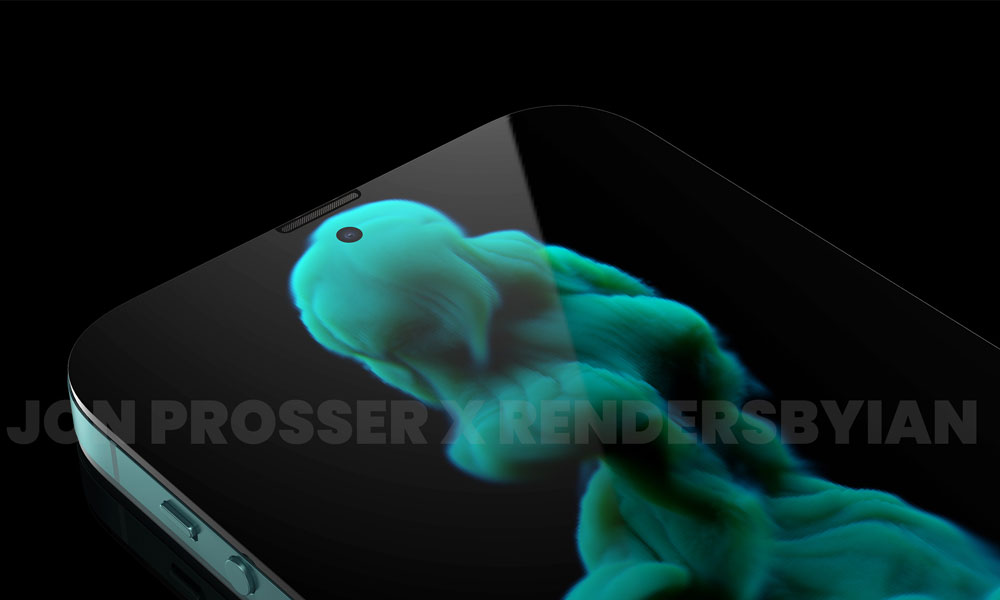Next Year’s ‘iPhone 14’ Could Finally Gain Under-Display Face ID, Punch-Hole Camera
 Credit: Front Page Tech / Renders by Ian
Credit: Front Page Tech / Renders by Ian
Toggle Dark Mode
We’re less than a week away from the iPhone 13 unveiling, and even though this year’s model hasn’t hit the streets yet, rumours are ramping up from various sources about what could be coming to next year’s so-called “iPhone 14,” and things are starting to sound interesting.
Yesterday, prolific leaker Jon Prosser provided a series of renders showing what the 2022 iPhone lineup might look like, showing a look that could be a throw-back to the design of the elegant iPhone 4 era. The renders showed a completely flush back with no camera bump, as well as the elimination of the iPhone notch in favour of a punch-hole style front camera.
Although we’ve been hearing reports for years of Apple’s efforts to eliminate the iPhone’s unsightly notch, the biggest obstacle has always been the need to make room for the sophisticated TrueDepth camera sensors that are not only required to support Face ID authentication, but also features like Portrait Mode selfies, Animoji, Slofies, and cool things like “Selfie Scenes” in Apple’s creative Clips app.
Some reports speculated that Apple might be so desperate to eliminate the notch that it would abandon Face ID to do so. Apple’s work on in-display Touch ID, these reports claimed, would obviate the need for Face ID authentication, allowing Apple to go with a much smaller and simpler front camera that could be embedded in the bezels.
Since the TrueDepth camera is about more than Face ID, however, this approach always seemed unlikely to us, and as more analysts began to share details on Apple’s plans for in-display Touch ID, it became clear that this was either destined for lower-end iPhone models where Apple could cut corners by removing the TrueDepth camera array entirely, or simply as a second authentication method.
As the events of the past year have shown the challenges of using Face ID when wearing a mask, it’s easy to see how offering Touch ID as an alternative could be very useful. To be fair, Apple has already come up with a clever mask-aware Face ID solution for Apple Watch users, but that’s a kludge at best.
‘Notchless’ Face ID
Since Apple is unlikely to ever pull out the TrueDepth camera from its flagship iPhone models, it will need to find a more creative way to get rid of the notch.
In short, Apple needs to find a way to make Face ID — and the other important TrueDepth-powered features — work through a much smaller window on the front of the iPhone.
According to a March report from analyst Ming-Chi Kuo, the punch-hole design highlighted this week by Jon Prosser has been in the works for some time, but neither Kuo nor Prosser have had too many insights on the technology behind it.
Reports that Apple is working on a unibody lens design could help to solve some of the issues by compacting the camera modules, but it’s unlikely this would make them small enough to fit into a traditional punch-hole camera, where the goal is to make the hole as small and unobtrusive as possible.
Display analyst Ross Young has another theory: Apple will move at least some of the Face ID components behind the display.
Young’s entire focus is on display technology and the related supply chain behind it, and as a result, he often has some useful and prescient insights into what Apple is up to. For instance, despite multiple rumours that pointed to the iPhone 12 Pro getting new 120Hz LTPO displays, and even leaked photos showing the settings on an iPhone 12 Pro Max, Young was the first to accurately predict last fall that Apple would be holding off on the new tech due to supply chain problems.
While Young predicted the arrival of under panel Face ID for the 2022 iPhone back in June, he reiterated those comments yesterday, sharing his overall predictions for the screens that will grace the full “iPhone 14” lineup next year.
Of course, it’s still very early in the development cycle for next year’s iPhones, and while this looks like good evidence that Apple is at least working in this direction, it’s unclear if the technology has been perfected.
Rival smartphone makers have tried under-display cameras already, and it’s generally been a mess. However, it appears that Apple is looking toward the hybrid approach of using a punch-hole for the actual image sensor while hiding some of the other TrueDepth camera components behind the display.
As Young notes in a subsequent tweet, this should be much easier than full under panel cameras, although he also adds that it’s far from final.
It’s likely that the removal of the “iPhone 14” notch is entirely dependent on Apple getting this under-display Face ID technology working properly, and at least six months to go before the new iPhone design is anywhere near finalized, we’ll have to wait and see what actually happens. Regardless, it’s an interesting insight into what Apple wants to do with the future of the iPhone — the only real question is whether it can pull it off for next year.
[The information provided in this article has NOT been confirmed by Apple and may be speculation. Provided details may not be factual. Take all rumors, tech or otherwise, with a grain of salt.]






